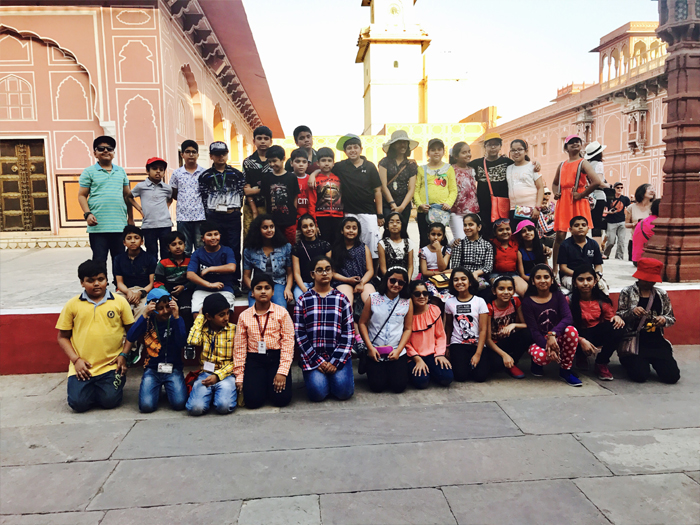- About us
- Classrooms
-
Beyond Classrooms
- Beyond Classrooms
- Environmental Concerns
- Expeditions, Camps and Excursions
- Girton College(Cambridge)- The Indian School Essay Writing Competition
- Interactive Assemblies
- International Links
- Leadership Training
- Self Discovery
- Sharing our quest for Excellence in Learning
- Sports and Physical Education
- The Citizenship Programme
- Gallery
- Alumni

Board Results 2023-24 :
...click here for details
School trip to Jaipur for classes 4 and 5
Early morning on 21 March, 2017, 40 students of classes IV and V, with 4 teachers assembled at School to leave for a trip to Jaipur ( the Pink City), an extremely popular tourist destination, for three days and two nights.
Jaipur is one of the most vibrant and colourful cities of India, famous for its culture, its magnificent forts, palaces and lakes. We started our journey at 6 am. Laughter, songs and jokes were a constant in the six hour long bus ride!
After arriving at Jaipur, the group geared up for the first sightseeing tour which comprised a visit to Jantar Mantar and the City Palace. Jantar Mantar, a UNESCO World Heritage site, built in 1738 by Maharaja Sawai Jai Singh, houses a unique and impressive collection of astronomical instruments. We could observe various astronomical positions with the naked eye! Students were amazed to learn how, in earlier times too time was estimated and people studied about stars and planets. They learnt and even rose to the challenge of predicting time using basic instruments.
The next stop was the City Palace. Its major part is now the Maharaja Sawai Mann Singh II Museum. Our tourist guide enjoyed a captivated audience and told us stories about the princes of Jaipur, their valour and conquests. The swords and other weaponry, amongst the other belongings of the royal family were the major attractions here. The guide recreated the period in history through stories about the royals. The height and girth of the prince can be assumed from the proportions of his dress tdisplayed in the museum, he pointed out- It was humungous!
[gallery link="file"]He was the 10th King of Jaipur. The entire palace is very delicately and beautifully carved. We were astonished to know that a part of the palace still serves as imperial residence to the present Maharaja. The next morning, we set out to explore the Amer Fort. It is a mesmerizing combination of conventional Rajasthani and Mughal architecture, built in the 16th century. The guide showed us the entire fort with detailed explanation. Within its powerful walls one finds charismatic gardens and magnificent palaces made from marble and precious stones, richly festooned with intricate stonemason works and paintings. The best part of the palace is the Sheesh Mahal, a delightful hall of mirrors that are so artistically set that even a tiny ray of light gets replicated in the mirrors and illumines the hall flamboyantly. It was a visual treat for all of us. In the evening after enjoying the delicious lunch, we left for the much-awaited visit to Chokhi Dhani, a Rajasthani village recreated to help people understand Rajasthani lifestyle, art, and culture. Children adored a bevy of traditional entertainment dancers, acrobats, snack stalls and other activities like camel ride, horse ride and camel cart ride. They relished a delicious meal in a pure traditional Rajasthani style. On the last day children were taken to visit the Birla Temple, and the museum below it. It is a great piece of beauty and splendor. Dedicated to Goddess Laxmi and Lord Vishnu, the temple is also popularly referred to as Laxmi Narayan Temple. It is made of pure white marble and the temple walls adorn the carvings of the scenes of mythology and quotes from Gita. The main highlight of the temple is the images of Goddess Laxmi and Lord Vishnu sculpted out of a single piece of marble. It was utterly mesmerizing. Alas, before we knew it, the three fun-filled days were over and it was now time to go back. The trip was an educative and a memorable one!
Mehak Gumber











